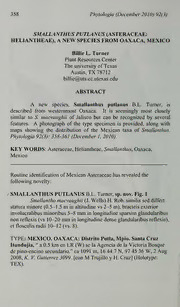
Smallanthus putlanus (Asteraceae: Heliantheae), a new species from Oaxaca, Mexico PDF
Preview Smallanthus putlanus (Asteraceae: Heliantheae), a new species from Oaxaca, Mexico
358 Phytologia (December2010) 92(3) SMALLANTHUSPUTLANUS(ASTERACEAE: HELIANTHEAE), A NEW SPECIES FROM OAXACA, MEXICO Billie L. Turner Plant Resources Center The university ofTexas Austin, TX 78712 [email protected] ABSTRACT A new species, Smallanthus putlanus B.L. Turner, is described from westernmost Oaxaca. It is seemingly most closely similar to S. macvaughii of Jalisco but can be recognized by several A features. photograph of the type specimen is provided, along with maps showing the distribution of the Mexican taxa of Smallanthus. Phytologia 92(3): 358-361 (December 1, 2010). KEY WORDS: Asteraceae, Heliantheae, Smallanthus, Oaxaca, Mexico Routine identification ofMexican Asteraceae has revealed the following novelty: SMALLANTHUS PUTLANUS B.L. Turner, sp. nov. Fig. 1 Smallantho macvaughii (J. Wells) H. Rob. similis sed differt statura minore (0.5-1.5 m in altitudine vs 2-5 m), bracteis exterior mm involucralibus minoribus 5-8 in longitudine sparsim glandularibus mm non reflexis (vs 10-20 in longitudine dense glandularibus reflexis), et flosculis radii 10-12 (vs. 8). TYPE: MEXICO. OAXACA: Distrito Putla, Mpio. Santa Cruz Itundujia, " a 0.5 km en LR (W) se la Agencia de la Victoria Bosque de pino-encino secundario." ca 1091 m, 16 44.7 N, 97 45 36 W, 2 Aug M 2008, K. V. Gutierrez 3099. [con Trujillo y H. Cruz] (Holotype: TEX). Phytologia (December2010) 92(3) 359 Perennial herbs, 0.5-1.5 m high. Stems villous, arising from woody, corm-like structures, out of which are produced lateral ligneous rootstocks with villous hairs. Leaves thin, opposite, 25-30 cm long, 12- 14 cm wide; lower surfaces ofblades glabrous, hastately to pinnately lobed, the margins finely ciliate; petioles 5-6 cm long, winged throughout, ca 1 cm wide, auriculate at base. Capitulescence a terminal, 2-headed raceme, the ultimate peduncles glandular-pubescent, 3-4 cm long. Heads ca 3 cm across the extended rays; chaffscarious, linear-lanceolate, slightly shorter than the disk florets. Outer involucral bracts 5, narrowly ovate, 5-8 mm long, 2-4 mm wide. Ray florets10-12, pistillate, fertile, the ligules yellow, villous at the very base. Disk florets sterile (?), 30-40, yellow, sparsely pubescent. Achenes ofray florets fertile, ovoid ortear-shaped, glabrous. Leaf texture and pubescence ofS. putlanus is especially like that ofS. macvaughii. When first discerned, I took the present novelty to be a species of the small, mostly herbaceous, genus Axiniphyllum (Turner 1978), largely because the type itselfwas only ca 0.5 cm high. The label data, however, give its height as 1.5 m, more like that of a Rutnfordia, or Smallanthus. In my evaluation of its generic position, the defining characters for S. putlanus, were the seemingly rounded, or tear shaped, ray achenes and sterile disk florets, instead of4-sided and fertile, as found inAxiniphyllum, and Rumfordia. Geographically speaking, Smallanthus putlanus might also be compared with S. oaxacanus (Sch.-Bip.) ex Klatt) H. Rob., an orange- rayed shrubby species of more eastern Oaxaca (Turner 1988). The distribution ofthe Mexican species ofSmallanthus is shown in Figs 2- 3. The name is derived from the Distrito de Putla, Oax, whence the type. ACKNOWLEDGEMENTS As always, I am grateful to my colleague, Guy Nesom, for the Latin diagnosis, and helpful suggestions on the manuscript itself. Maps are based upon specimens on file at LL-TEX. 360 Phytologia (December2010) 92(3) LITERATURE CITED Turner, B.L. 1978. Taxonomy ofAxiniphyllum (Asteraceae: Heliantheae). Madrono 25: 46-52. Turner, B.L. 1988. A new species of, and observations on, the genus Smallanthus (Asteraceae-Heliantheae). Phytologia 64: 405-409. If Fig. 1. Smallanthusputlanus (holotype). Phytologia (December2010) 92(3) 361
